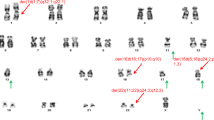Abstract
The cytogenetics of HNE-1 cell line derived from the biopsy of nasopharyngeal carcinoma of a 27- year- old Chinese male has been investigated by chromosomal banding technique. A karyotypic characterization of subteraploid and a modal number of 74–77 have been revealed in this cell line. All cells contained a series of non- random chromosomal rearrangements. 18 of them, including 5 isochromosomes. were present in all metaphases and 3 of them in a few one. These findings indicated that the severe DNA damage and increase of gene copies may be occurred in genome of HNE-1 cells.
Similar content being viewed by others
References
Laboratory of Tumor Viruses of Cancer Institute and Other Institutions in China. Establishment of an epithelial cell line and a fusoform cell line from a patient with nasopharyngeal carcinoma. Scientia Sinica 1978; 21:127.
Huang DP, et al. Establishment of a cell line (NPC/HK-1) from a differentiated squamous carcinoma of the nasopharyx. Int J Cancer 1980; 20:127.
Mitelman F. Chromosome patterns in human cancer and leukemia. In: Chromosomes and Cancer. New York. 1983; 61–83.
Finerty S, et al. Cytogenetics of malignant epithelial cells and lymphoblastoid cell line from nasopharyngeal carcinoma. Br J Cancer 1978.
Wu B, et al. Study of giant group A marker chromosome in several Burkitt’s lymphoma and lymphoblastoid cell lines with Epstein Barr Virus from different origins. Chinese Med J 1980; 93:400.
Zhang S, et al. Cytogenetic studies by chromosome banding techniques on peripheral blood cells from nasopharyngeal carcinoma patients. Chinese Med J 1980; 93:251.
de la Chapells A. How do human isochromosomes arise? Cancer Genet Cytogenet 1982; 5:173.
Atkin NB, Baker M. Small metacentric marker chromosomes, particularly isochromosomes, in cancer. Hum Genet 1988; 79:96.
Mitelman F. Restricted number of chromosomal regions implicated in aetiology of human cancer and leukemia. Nature 1984; 310:325.
Author information
Authors and Affiliations
Rights and permissions
About this article
Cite this article
Li, G., Yao, K. Cytogenetic study on a new epithelial cell line, HNE-1, derived from nasopharyngeal carcinoma. Chin J Cancer Res 3, 31–36 (1991). https://doi.org/10.1007/BF02997274
Issue Date:
DOI: https://doi.org/10.1007/BF02997274




